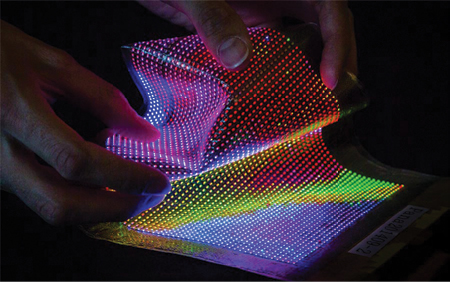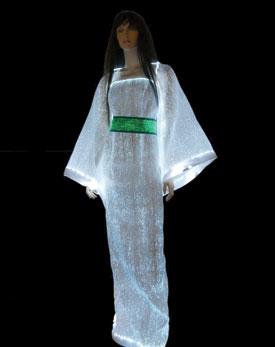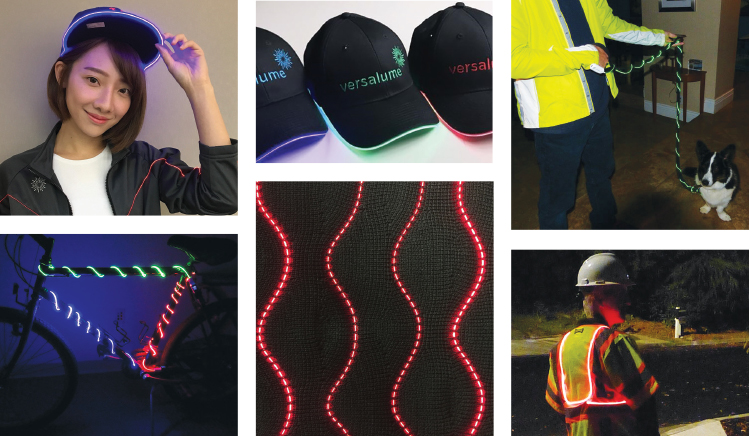
A microLED panel, one of the many examples of wearable photonics technology. The closely space pixels can be integrated into flexible materials and used for personal wearable displays. Image courtesy of the Holst Centre and LaserFocusWorld.com.
New Changes in the Hands of the Everyday Individual: Photonics in Wearable Technology
With rapid advancements in common devices like phones and watches, technology has become more prominent in everyday life. Much of society depends on technology, from performing life-saving procedures to tracking the rise and fall of the economy. Wearable technology is a prominent example of this, such as fit bits which track the health of individuals.
However, much of this wearable technology uses light. Various industries such as field services, logistics, and energy use these devices. Whether it is emitting light into the skin for monitoring vitals or from the garments of rescue workers, light plays a crucial role.
Prominent Examples of Wearable Phonotics
Determining which wearable technology is part of the wearable photonics category is not completely clear. Some of the more prominent examples include wearable computing devices, visual display headsets/glasses and biosensors. One of the most interesting examples are the flexible organic light-emitting diodes (OLEDs) that are a part of various flexible or textile-based displays, similar to the one shown in the image above.
Describing the Science Behind Photonics Textiles: Advantages and Uses

Side-illuminating optical fibers coupled to LEDs in clothing. One of the many ways that textiles can bring inert objects to life. Image courtesy of LumiGram and LaserFocusWorld.com.
Recently, scientists have become very interested in photonics textiles as an example of wearable photonics and for good reasons. They offer a number of advantages that conventional electronic circuits cannot provide. Many of the typical electronic circuits are compact and are highly functional. However, they are limited by the maximum substrate size that can be processed. Additionally, many circuits are too rigid or too fragile under certain conditions.. They also can’t be integrated into environments that involve a lot of motion.
By contrast, smart textiles such as those based on OLEDs overcome this issue. They offer the possibility for large area sensing and illumination. Furthermore, they can be integrated with different materials and encapsulate a variety of areas of different shapes and sizes. Additionally, they can potentially work well with certain textiles that offer breathability, comfort, and low cost, while the OLEDs themselves can potentially offer diffuse illumination and low energy consumption.
Comparing OLEDs to LEDs
Many scientists choose to use OLEDs over LEDs with this wearable photonics technology because of the many advantages they offer in comparison. For example, OLEDs can emit homogeneous light over a larger surface area and are more aesthetically pleasing. This latter point is particularly important since musicians and other performers use these types of clothing in their shows. Furthermore, OLEDs are lighter, have a flat form factor, and are more flexible when designers fabricate them on a polymer foil substrate.
Design Challenges and Issues to Consider with OLED’s in fabrics
Even with all of these benefits that OLEDs provide they still present design challenges. There are limitations on how long the OLEDs last. While some design engineers encapsulate them with glass to solve this issue, this makes the OLEDs rigid and less suitable for integrating them with textiles and different fabrics. Additionally, there are energy issues to consider as scientists still struggle with how to properly distribute energy to create a uniform amount of light throughout the entire garment. The size and weight of the power source is one of the biggest challenges that will require more research to make this technology more practical.
Additional Examples of Wearable Photonics
Wearable photonics are becoming increasingly prominent in many industries beyond entertainment and in areas other than clothing. Many of these products come with single color lasers and are either red, green, or blue. Apple recently became involved in the game with a Bluetooth-controlled RGB smart module with an iOS app.
More than just aesthetically pleasing and as mentioned previously, wearable photonics devices are becoming increasingly prominent in everyday life. Some of the more important examples include neon-like fibers into automative heads up displays, video games, architectural lighting, construction worker safety equipment/clothing, and light blinkers for people exercising in the dark.

A wide range of wearable photonics by Versalume. The company is commercializing Corning Fibrance optical fibers for personal fashion, safety equipment, and numerous other areas. Image courtesy of Versalume and LaserFocusWorld.com.
Fitness and Health Tracking
One of the more commonly observed examples of wearable technology these days can be seen in smart watches that track vitals such as the human heart rate while running or fitbits. Engineers have worked on bringing wearable photonics into this industry to track many different health and stress vitals. Researchers at the University of Texas at Dallas and EnLiSense have developed a wearable sensor. This sensor can track glucose and cortisol levels among other things. Nature.com contains more details on this sensor.
The device works by using zinc-oxide thin films on nonporous polyamide substrates to determine portent and cortisol levels in human sweat. These readings indicate certain health conditions and the devices also use fourier-transform infrared spectroscopy (FTIR) and dynamic light scattering (DLS) optical methods to improve their sensing capabilities. As mentioned previously glucose sensing is another benefit. This could provide a big help to people who have to watch their glucose levels very carefully such as those with diabetes. The devices work by using photo acoustic spectroscopy (PAS) to obtain a mid-infrared spectrum when glucose molecules absorb a sound signature that records sugar levels in skin cells. It is an example of the potential applications of wearable photonics technology.
Potential Future Directions of the Industry
Many companies spend lot of money on developing wearable technology. They provided up to $10.6 billion in sales in 2017 and will possibly provide up to $150 billion by 2027. Many industries including medicine, retail, and entertainment use these types of devices. As scientists discover ways to integrate technology into wearable devices that use photons and make wearable photonics, they may one day be found in every industry.

Amazing. How much power it consumes and from which source? Must be button cell. Nice